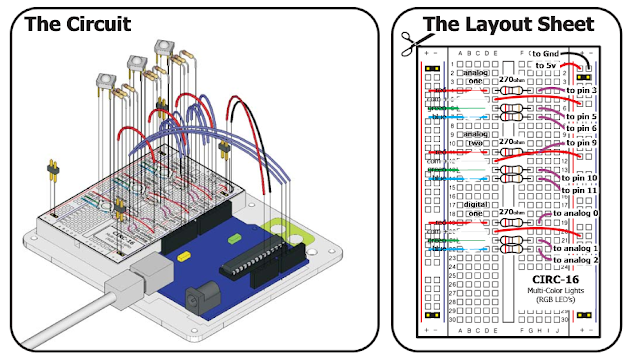Multi Color LEDs-Make Them In Work For Your Projects
Introduction
Till now you might be thinking that there is only one type of LEDs that generate only one type of color, i.e., anyone of the following, RED, GREEN, BLUE, etc. And yes there is one more kind of LED, that generate no color, but still works, & have effect in the applications in which it is used, that LED we known as Infra Red LED.
But this is not the end of the Light Emitting Semiconductor device family, there is group ( of LED ) that are capable of generating various color though they are of same size, same number pins, or even various things that are similar.
| LED Family- Includes, single color, Bi-Color & RGB LEDs |
| Single Colored LEDs ( RGY ) |
| Multicolored LED Pattern |
Bi-Color LEDs:(Actually Capable Of Generating 3 Colors)
So lets see the below equivalent circuit of a bicolor LED (Common Anode one) & try to understand a bit about it...
| Bi-Color LED General Equivalent Circuit Diagram |
| Bi Color LED Schematic |
From the above two pictures we can say that the there are three pins of it, instead of the common two pins, the common pin ( The middle pin ) which will be attributing it to be a common Anode or Common Cathode will help us decide that wether a +5V power supply has to added or GND has to be applied(if its common anode then apply GND to the middle/common pin other vise viceversa). The First pin of the above LED is attributed to generate the Green color & the third pin will generate Red color if a positive voltage supply is given to it, in case of common anode or GND to it in case of Common Cathode. What if we make the 1st & the 3rd terminal either +5V or GND, well in that case it will simply either switch off ( In reverse biased condition) or both the color will be producing simultaneously resulting in a different 3rd color.
| A Bi-Color LED |
| FYL-3015xx Bicolor LED Schematic |
| Bipolar LED Driver |
In the above circuit the 555 timer circuit will be producing the square wave, in the negative cycle it will be compelling the LED to generate RED led & green one in positive cycle. So there will be a tick-tock between RED & Green color in that LED.
RGB LEDs or Tri-Color LEDs
| Equivalent Circuit Of RGB LED |
They are also of two types, similar to the Bi-Color LEDs, i.e., common anode & common cathode. They are able to generate Red, Green & Blue, in addition to them the color possible by combining them. Actually Controlling the RGB LED digitally 7 colors are achievable:
 |
| Different Color Combination Possible Analogically & Digitally |
| RGB LEDs Producing different color in one of the application |
Another Type Of RGB LED That Are Available in the Market Is:
 |
| RGB LED Pin Configuration (source : pjrc .com) |
Longest lead (pin 2) is Cathode (-)
Pin 1 -( emits light of 650nm) Green - Short Lead (same length as Green)
Pin 2 - Negative/Cathode Longest lead
Pin 3 - CB (emits light of 470nm) - Blue - 2nd longest lead
Pin 4 - BG (emits light of 520nm) - Red - Short lead (same length as red)
Pin 2 (longest) is the common cathode to all 3 colors.
Some Application Circuits:
RGB LED COLOR FLASHER USING ARDUINO
 |
| Project Schematic Generated by Fritzing Software(we will be posting tutorial on the soon! So Stay Tuned) |
ELECTRIC MOOD CUBE
| LED Mood Cube |
